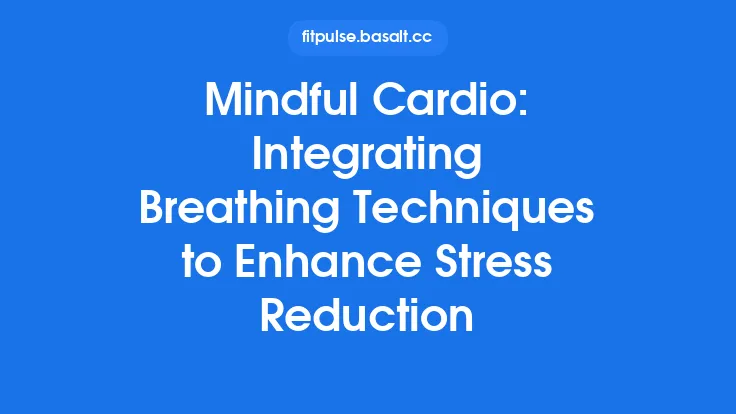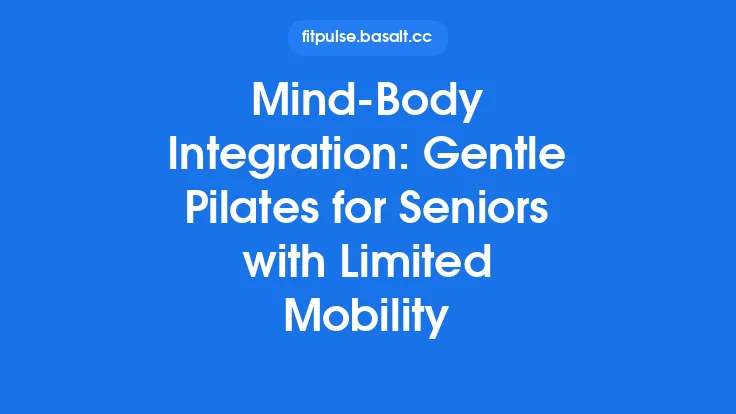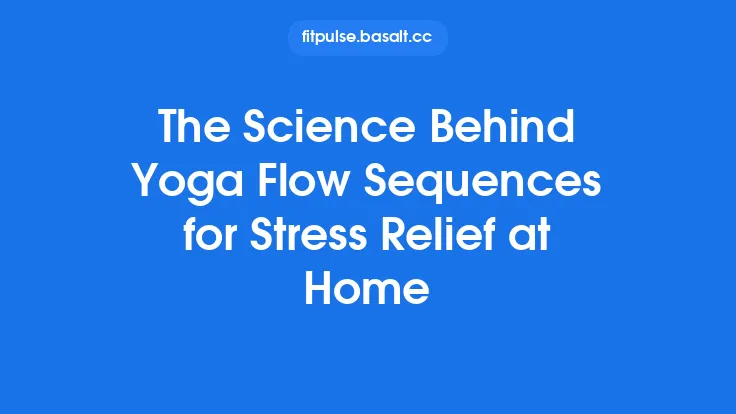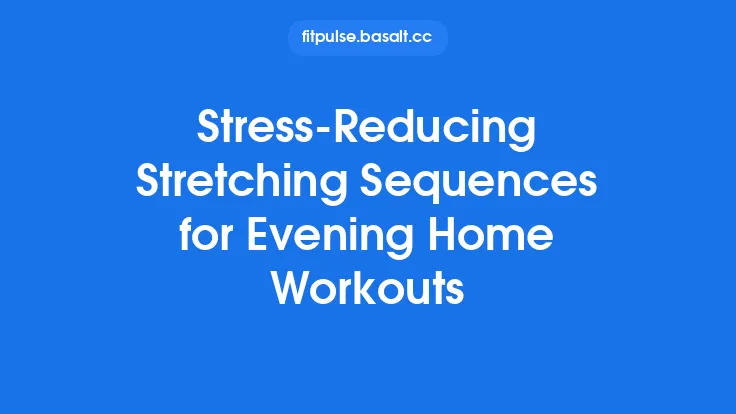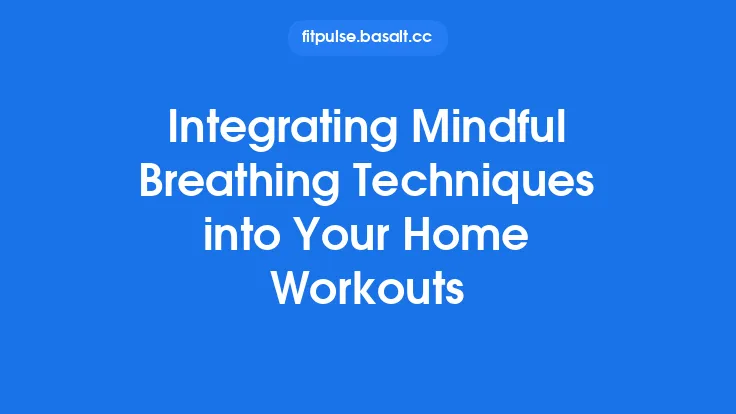Pilates, with its emphasis on precise movement, core stability, and controlled breathing, offers a uniquely effective pathway to reduce everyday stress while strengthening the body. When practiced mindfully at home, the method becomes more than a series of exercises—it transforms into a moving meditation that calms the nervous system, sharpens focus, and promotes a resilient mindset. Below is a comprehensive guide that blends core Pilates principles with stress‑reduction strategies, giving you a sustainable, evergreen routine you can perform in any modest living space.
The Core Philosophy Behind Pilates
Pilates was created by Joseph Pilates in the early 20th century as a system to “control the body, not the mind.” The method rests on six foundational principles that, when internalized, become tools for managing stress:
| Principle | What It Means | Stress‑Reduction Link |
|---|---|---|
| Concentration | Full mental presence on each movement | Directs attention away from rumination |
| Control | Every action is intentional, not reflexive | Reduces the feeling of being “out of control” |
| Centering | Engaging the “powerhouse” (deep core) | Activates the parasympathetic nervous system |
| Precision | Small, accurate motions over large, sloppy ones | Encourages a calm, methodical mindset |
| Breath | Coordinated inhalation and exhalation with movement | Supports oxygen flow and nervous‑system balance |
| Flow | Smooth transitions between exercises | Maintains a rhythmic, soothing pace |
Understanding these principles is the first step toward turning a physical workout into a mental reset.
Core Activation: The Stress‑Relieving Engine
The deep abdominal muscles—transversus abdominis, multifidus, diaphragm, and pelvic floor—form the “core” or “powerhouse.” Engaging this region does more than improve posture; it sends a signal to the brain that the body is stable, which in turn dampens the stress response.
How to Feel Core Engagement
- Neutral Spine Position – Lie on your back, knees bent, feet flat. Gently tilt the pelvis to create a small curve in the lower back, then flatten that curve while keeping the ribcage relaxed.
- Micro‑draw – Imagine pulling the navel toward the spine without holding your breath. This subtle contraction activates the transversus abdominis.
- Pelvic Floor Cue – Slightly lift the muscles you would use to stop urine flow. This adds a supportive layer beneath the abdominal wall.
When practiced consistently, this “core lock” reduces cortisol spikes by signaling safety to the hypothalamic‑pituitary‑adrenal (HPA) axis, the body’s primary stress regulator.
Mindful Awareness in Motion
Mindfulness in Pilates is not a separate meditation; it is woven into the execution of each exercise. The key is to maintain a single‑point focus on the quality of movement rather than the quantity of repetitions.
Techniques for Embedding Mindfulness
- Sensory Scanning – As you move, notice the contact points (mat, floor, hands, feet). Feel the tension in the muscles and the release as you complete a contraction.
- Internal Timing – Count silently “one‑two‑three” for each phase (inhale, move, exhale, return). This internal rhythm anchors attention.
- Visual Cueing – Picture the spine lengthening like a string pulled from the crown of the head, while the core draws inward. Visualizing the spine’s alignment reinforces both posture and mental clarity.
These practices keep the mind anchored to the present, preventing the mental drift that fuels anxiety.
Building a Home Pilates Routine for Stress Relief
A well‑structured session balances core work, spinal articulation, and controlled movement. Below is a sample 30‑minute flow that can be performed on a yoga mat with a small pillow or folded towel for support.
| Time | Exercise | Reps / Duration | Core Cue |
|---|---|---|---|
| 0‑5 min | Pelvic Tilts (supine) | 10 slow tilts | Initiate with micro‑draw |
| 5‑10 min | Spine Stretch Forward (seated) | 8 reps | Keep ribs down, engage core |
| 10‑15 min | Single‑Leg Circle (supine) | 5 circles each direction per leg | Maintain neutral pelvis |
| 15‑20 min | Rolling Like a Ball | 6 rolls | Core tight, control descent |
| 20‑25 min | Side‑Plank with Knee Dips | 5 dips each side | Keep hips stacked, breathe with each dip |
| 25‑30 min | Modified Swan (prone) | 8 lifts | Lift chest using back extensors, not neck |
Progression Tips
- Increase Reps Gradually – Add one extra repetition every week rather than jumping to a higher count.
- Add Light Resistance – Use a resistance band around the thighs for the Single‑Leg Circle to deepen core engagement.
- Introduce Variations – Swap Rolling Like a Ball for Teaser once you can maintain a stable V‑position for 10 seconds.
Adapting the Practice to Your Lifestyle
Stress levels fluctuate, and your Pilates routine should be flexible enough to accommodate those changes.
| Situation | Adaptation |
|---|---|
| High‑Energy Day | Shorten the session to 15 minutes but increase intensity (e.g., add a band). |
| Low‑Energy Day | Focus on slower, more deliberate movements; extend the hold time of each position. |
| Limited Space | Perform all exercises on a folded towel; use a sturdy chair for support in side‑plank variations. |
| Joint Sensitivity | Replace Rolling Like a Ball with Cat‑Cow on hands and knees, preserving spinal articulation without impact. |
By matching the routine to your current state, you avoid the frustration that can arise from a rigid program, thereby preserving the stress‑relieving benefits.
Common Pitfalls and How to Avoid Them
- Holding the Breath – Even though Pilates integrates breath, many beginners unintentionally hold it during core contractions. Practice the “inhale‑exhale‑inhale” pattern: inhale to prepare, exhale while engaging, inhale to release.
- Over‑arching the Lower Back – When the core is disengaged, the lumbar spine may hyperextend, leading to tension. Keep the pelvis neutral and the ribs down throughout.
- Rushing the Flow – Speed defeats the purpose of mindful movement. Use a metronome set to 60 bpm or count slowly to maintain a calm tempo.
- Neglecting Alignment – Misaligned shoulders or hips shift the load to secondary muscles, creating unnecessary strain. Use a mirror or record yourself to self‑check alignment.
Addressing these issues early ensures the practice remains a source of calm rather than a trigger for physical discomfort.
Equipment and Space Considerations
You don’t need a full‑size Pilates reformer to reap the benefits. A few inexpensive items can enhance comfort and effectiveness:
- Mat – Choose a non‑slip surface with moderate thickness (6‑8 mm) to protect joints.
- Small Pillow or Towel – Provides lumbar support for supine exercises and can be used as a prop for shoulder alignment.
- Resistance Band – Adds progressive load for leg and arm work without bulky equipment.
- Wall Space – Useful for “Wall Roll‑Down” variations that help maintain spinal alignment.
Even a modest living‑room corner (approximately 2 m × 2 m) is sufficient when the area is cleared of clutter and the floor is stable.
Tracking Progress and Maintaining Consistency
Consistency is the bridge between occasional workouts and lasting stress reduction. Here are practical ways to monitor and sustain your practice:
- Exercise Log – Record the date, duration, and any modifications. Note subjective stress levels before and after the session on a 1‑10 scale.
- Video Review – Once a month, film a full routine and compare alignment and fluidity to previous recordings.
- Goal Setting – Set SMART (Specific, Measurable, Achievable, Relevant, Time‑bound) goals, such as “Hold the Modified Swan for 15 seconds by week 4.”
- Reward System – Pair milestones with non‑food rewards (e.g., a new Pilates strap, a relaxing bath) to reinforce habit formation.
Over time, you’ll notice not only physical improvements—stronger core, better posture—but also a measurable decline in perceived stress.
Integrating Pilates Into a Holistic Stress‑Management Lifestyle
While this article focuses on the movement component, the benefits of Pilates are amplified when paired with complementary lifestyle habits:
- Adequate Sleep – A rested nervous system responds better to the calming effects of core work.
- Balanced Nutrition – Stable blood sugar supports sustained concentration during sessions.
- Regular Outdoor Breaks – Brief exposure to natural light can reset circadian rhythms, enhancing the restorative impact of your home practice.
These synergistic practices create a feedback loop: as Pilates reduces stress, you’re more likely to maintain healthy sleep and nutrition, which in turn further lowers stress.
Final Thoughts
Mindful movement through Pilates offers a timeless, evidence‑based avenue for stress reduction that fits comfortably within the home environment. By honoring the six Pilates principles, emphasizing core activation, and embedding mindful awareness into each repetition, you transform a simple workout into a powerful mental reset. The routine outlined above is deliberately evergreen—no trendy equipment, no fleeting fads—ensuring that you can return to it day after day, season after season, and continue to harvest both physical strength and emotional resilience. Embrace the practice, stay present, and let the steady rhythm of controlled movement become your personal sanctuary from the demands of modern life.
